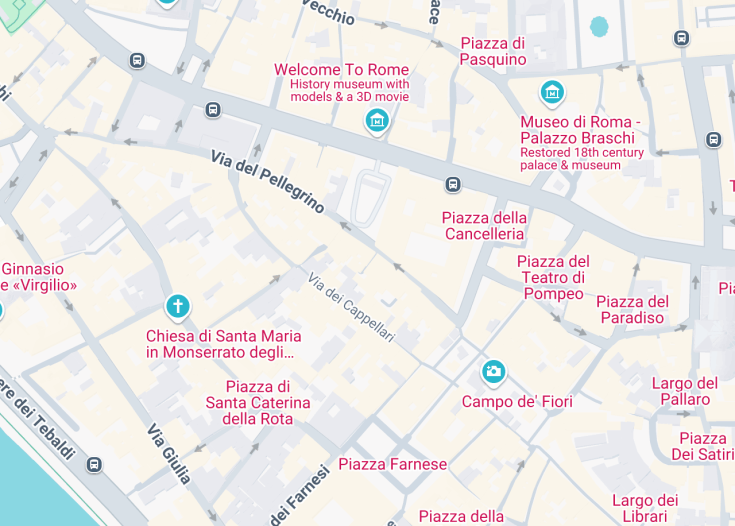The Arco di Santa Margherita is a charming arch located in the historic heart of Rome, Italy, specifically in the enchanting Vicolo di Santa Margherita. This architectural gem, adorned with a Baroque tabernacle depicting the Madonna and Child along with Saint Philip Neri, serves as both a piece of history and a testament to the city’s rich cultural heritage.
Visitors should pay close attention to the intricate details of the Baroque tabernacle, which enhances the charm of Arco di Santa Margherita. The arch is not only a stunning visual but also a portal to Rome’s vibrant history.
While exploring the area, consider taking a moment to enjoy the atmosphere of the quiet, adjoining vicoli. These hidden alleys offer a peaceful contrast to the bustling tourist spots, providing an authentic Roman experience.
Exploring Arco di Santa Margherita in Rome, Italy
The Arco di Santa Margherita, a remarkable architectural feature located in the heart of Rome’s historic district, is an embodiment of the city’s rich cultural and spiritual heritage. Characterized by its baroque tabernacle dating back to 1716, the arch displays a stunning relief of the Madonna with Child and St. Philip Neri, cleverly integrated into the structure. This artistic element is not merely decorative but serves as an essential focal point for the pilgrimage tradition associated with the revered saint.
Adjacent to Via del Pellegrino, this small archway opens into a mysterious alley reminiscent of medieval Rome. The intricately designed tabernacle was commissioned by Cardinal Pietro Ottoboni, a prominent religious figure of the time, thus linking the arch to the Filippini Order. The decorative motifs, executed by Francesco Moderati, further attest to the artistic craftsmanship prevalent in the period.
Moreover, the arch holds remnants of cylindrical columns that once protected the corners of adjacent buildings from the bustle of traffic, reflecting the chaotic urban life from the 17th and 18th centuries. The careful preservation of such artifacts provides insight into the historical context of architectural adaptation in response to the city’s vibrant, albeit tumultuous, street life.
History
1716: Construction and Religious Significance
The Arco di Santa Margherita was constructed in 1716 as a site of spiritual significance, prominently featuring a tabernacle dedicated to the Madonna and St. Philip Neri. This addition to Rome’s architectural landscape signaled the intersection of faith and artistry, reflecting the Baroque style’s intricate detailing and emotional depth. The connection to Cardinal Ottoboni reinforced its religious importance within the community.
19th Century: Preservation and Cultural Context
By the 19th century, the arch had garnered a reputation not only as a religious icon but also as a cultural landmark. It served as a point of reflection for many, including notable figures such as Aldo Fabrizi, who reminisced about its historical essence amidst the changing urban landscape. Efforts were made to preserve its artistic features, which included provisions for its maintenance and adaptations to modern challenges.
Modern Times: Cultural Heritage Protection
In contemporary Rome, the Arco di Santa Margherita stands as a testament to the city’s ongoing commitment to preserving its historical legacy. Recent initiatives focus on safeguarding such landmarks from urban degradation while promoting their educational value. The arch continues to attract visitors fascinated by its rich history and intricate art, contributing to Rome’s identity as a city steeped in history and culture.
Experiencing the Atmosphere at Arco di Santa Margherita
Visitors to the Arco di Santa Margherita can immerse themselves in the tranquil ambiance that contrasts with the bustling surroundings. The arch is an ideal spot for reflection, allowing moments of contemplation in its shadow. Nearby, local artisans and shops offer traditional Roman crafts, providing an authentic experience. Furthermore, the location serves as a convenient route to nearby historic sites.
A Unique Blend of Art and Devotion
The arch’s baroque design and its tabernacle not only beautify the alley but also represent the deep-rooted traditions of Roman Catholic devotion. The presence of the relief sculpture, created by Moderati, captures the essence of religious veneration in a tangible form, drawing both pilgrims and art enthusiasts alike. As such, it stands as a crucial intersection of spiritual and artistic expression in Rome.
General informations
Location
The Arco di Santa Margherita is conveniently located in the charming Via del Pellegrino, near the vibrant Campo de’ Fiori area, which is famous for its market and lively atmosphere.
Address:
Via del Pellegrino, 00186 Roma RM, ItalyVisiting Information
The Arco di Santa Margherita is open to the public and can be visited freely at any time, as it is located in a public area. For optimal experience, visiting early in the morning or late afternoon might offer a more tranquil atmosphere.
How to reach Arco di Santa Margherita
Car
The Arco di Santa Margherita can be easily accessed by car. However, parking options are limited due to the central location, so consider using public transport for convenience.
| Route | Distance | Travel time |
|---|---|---|
| From Termini Station | 2 miles (3.2 Km) | 15 minutes |
| From Vatican City | 1.5 miles (2.4 Km) | 10 minutes |
| From Trastevere | 1.8 miles (2.9 Km) | 15 minutes |
Public Transport
Using public transportation is highly recommended for visiting the Arco di Santa Margherita due to the limited traffic in the area.
The following options are available:
- Bus: Multiple bus lines stop nearby, including lines 23 and 62.
- Metro: The nearest metro station is “Colosseo,” about a 20-minute walk away.
Accessibility and Limitations
The Arco di Santa Margherita is located in a pedestrian area, making it easily accessible for visitors. However, the narrow streets may pose challenges for individuals with mobility issues.
Accessibility
Limitations
- Limited space for large groups due to the narrow passages.
- Not suitable for wheelchair users due to uneven surfaces.
Notes to visitors
- It is advisable to be respectful of the surrounding residential area.
- Visitors should be mindful of their belongings due to the bustling nature of the nearby streets.
Common questions
What architectural styles are represented in the Arco di Santa Margherita?
The Arco di Santa Margherita in Rome showcases a delightful blend of architectural styles, primarily Baroque, which is evident in the intricate details of the tabernacle that adorns the arch. The edifice features a stunning baroque relief created by Francesco Moderati in 1716, portraying the Madonna with Child and Saint Philip Neri. The ornamentation and craftsmanship reflect the characteristics of the Baroque period, emphasizing dramatic expressions and elaborate designs.
Additionally, elements of medieval architecture are present, particularly in the overall structure of the arch, which has survived various urban transformations over the centuries.
This mix provides an insight into the evolving architectural practices in Rome, underscored by the historical significance and cultural heritage captured through these stylistic features.
What are some notable nearby landmarks to visit around Arco di Santa Margherita?
When visiting the Arco di Santa Margherita, there are several notable landmarks nearby that enhance the cultural experience of the area. Just a short stroll away is the bustling Campo de’ Fiori, renowned for its vibrant market and lively atmosphere, especially in the morning. This square is perfect for soaking in local life and grabbing a bite from the surrounding cafes.
Another significant site nearby is the Church of San Filippo Neri, dedicated to the founder of the Oratory and closely linked to the tabernacle on the arch. The rich history and artistry of this church make it a worthwhile visit.
Additionally, you can explore Via dei Cappellari, a charming street filled with quaint shops and eateries, providing an authentic Roman experience.
All these landmarks highlight the intriguing mixture of history, culture, and daily life that characterizes the area surrounding the Arco di Santa Margherita.
What artistic elements can be seen on the Arco di Santa Margherita?
The Arco di Santa Margherita is adorned with various artistic elements that reflect its religious significance and Baroque design. One of the most prominent features is the baroque relief created by Francesco Moderati, which showcases a detailed depiction of the Madonna holding the Child Jesus, accompanied by San Filippo Neri. This artwork embodies the spiritual devotion of the era and highlights the importance of these figures within Roman Catholic tradition.
Additionally, the decorative stucco work surrounding the relief adds to the visual appeal, characterized by its elaborate design typical of Baroque architecture. The arch itself has a modest yet elegant profile, emphasizing its historical role in the urban landscape.
Visitors can also observe the two eagles in the edifice that symbolize the commissioning cardinals, which adds a layer of historical context to the artistic elements present on the arch. Altogether, these features contribute to the arch’s status as a significant artistic landmark in Rome.
Can I take photographs at the Arco di Santa Margherita?
Yes, you can take photographs at the Arco di Santa Margherita. The arch is a publicly accessible site, and its stunning architecture, intricate details, and surrounding vibrant streets offer great opportunities for photography enthusiasts. The dramatic features of the arch, especially its Baroque relief and surrounding urban environment, make it an ideal backdrop for both casual snapshots and professional photography.
However, it’s advisable to be respectful of the surrounding area, particularly regarding local residents and private properties when taking photographs. Early mornings or later evenings might provide the best light for photography while allowing you to avoid larger crowds typical during peak visiting hours.
Exploring the nearby streets and landmarks can also lead to unique perspectives and additional photographic opportunities around the Arco di Santa Margherita.
What local foods should I try near the Arco di Santa Margherita?
When visiting the Arco di Santa Margherita, you’re in a prime location to indulge in some local Roman culinary delights. One must-try dish is “Pasta alla Carbonara,” a classic spaghetti dish made with egg, cheese, pork cheek, and pepper that’s loved by both locals and tourists alike.
Another popular choice is “Cacio e Pepe,” a simple but flavorful dish consisting of pasta, cheese, and black pepper, showcasing the traditional Roman emphasis on high-quality ingredients.
Don’t overlook the various pizzerias in the vicinity, where you can enjoy traditional Roman-style pizza, known for its thin crust and variety of toppings. Be sure to try a slice of “Pizza Bianca,” a local focaccia bread that is a perfect snack while exploring the area.
Finally, for dessert, grab a “Gelato” from one of the nearby gelaterias, which are plentiful around this iconic section of Rome. Sampling local foods adds to the richness of your experience at this historical site.

Is the Arco di Santa Margherita in Rome (Rome), Italy worth visiting?
The Arco di Santa Margherita is a delightful yet often overlooked arch located in the enchanting streets of Rome. Nestled in via del Pellegrino, this arch features a beautiful baroque tabernacle from 1716, depicting the Madonna and Child alongside St. Philip Neri. Visitors are treated to intriguing architectural details, including remnants of cylindrical columns that hint at the area’s bustling historical past. While it may not be a main tourist attraction, the arch offers a glimpse into Rome’s rich cultural heritage, making it an enriching stop for those wandering the city. The walk through the narrow, atmospheric vicoli that surround it enhances the experience, making it a worthwhile addition to any explorative itinerary. Don’t miss the chance to discover this hidden gem amid Rome’s vibrant tapestry.









